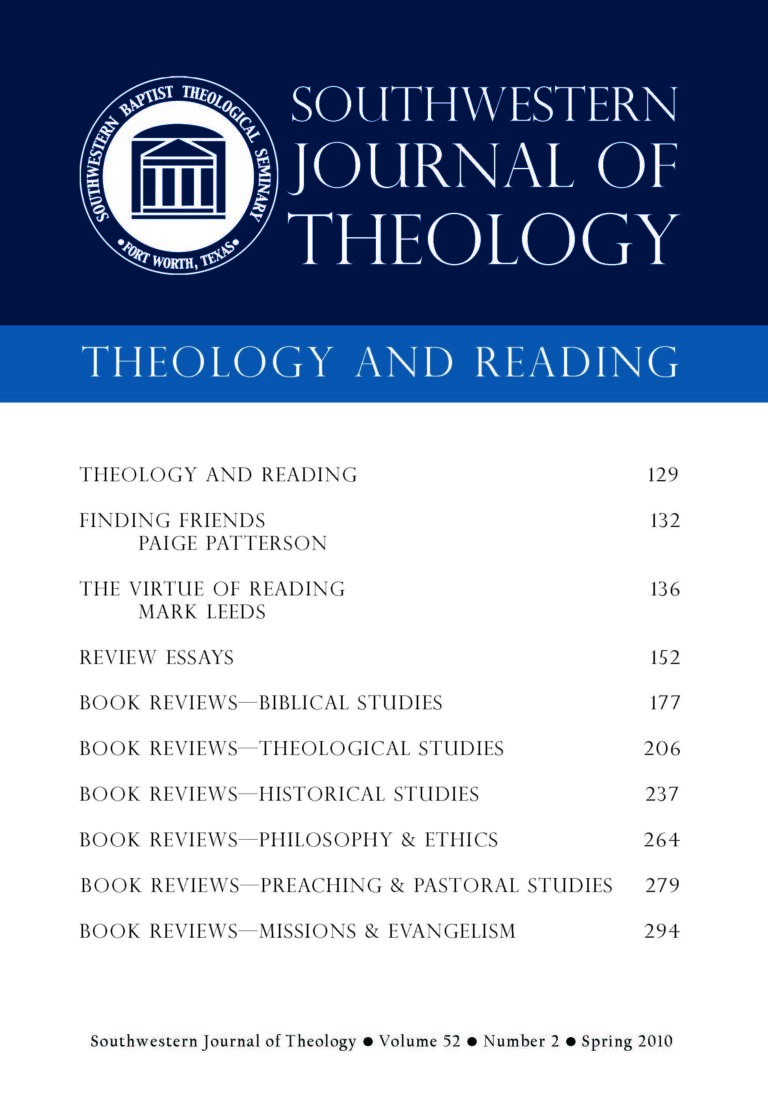
Theology and Reading
Southwestern Journal of Theology
Volume 52, No. 2 – Spring 2010
Managing Editor: Malcolm B. Yarnell III
By Alexander S. Jensen. London: SCM Press, 2007. 237 pages. Paperback, $22.79.
Alexander S. Jensen’s book gives an extensive historical overview of the shape and role of hermeneutics, beginning with Graeco-Roman antiquity and extending to the postcolonial perspectives of the twenty-first century. Writing for a burgeoning, neophyte academic audience, Jensen introduces his readers to the role that hermeneutics has played within theological circles while expressing the importance of critical self-reflection when engaging in constructive theological discourse—although even ripened theologians would be wise to heed his advice. He writes, “If readers do not reflect critically on their strategies, then they are in great danger of being beholden to some defunct ‘academic scribbler of a few years back’. They are likely to be unwitting adherents of some discredited hermeneutical theory” (3). He adds, “Unreflected hermeneutics will easily fall prey to unacknowledged prejudices, and there is no such thing as a natural or God-given way of understanding . . . Certain basic theological attitudes will always inform, if not determine, one’s hermeneutic. This needs to be brought to the fore and made explicit” (207). For Jensen it is imperative that theology be done responsibly, and this can only be accomplished if one is aware of the theological and hermeneutical assumptions to which they ascribe (189).
A key theme of Jensen’s book is the notion that all theological eras have been confronted with the challenge of “removing obstacles to understanding.” Various means have been sought to prevail over these impediments, and Jensen desires to reveal the strategies that have been employed by assorted theological, philosophical, and linguistic schools of thought. While the author does not prescribe one particular hermeneutical approach over another, Jensen consistently and reasonably points out what he perceives to be weaknesses in the strategies that he summarizes; therefore, he models for his readers the critical reflection that is advocated.
Jensen’s opening chapter appropriately introduces his readers to the hermeneutical spiral—the reciprocal exchange between theology and hermeneutics. The author maintains that every aspect of life is a process of interpretation; therefore, “all theology must first and foremost be hermeneutical theology” (4). Analogously, his closing chapter returns to this dialectical dynamic, although the author’s conclusion gives more credence to the influence of theological presuppositions on the hermeneutical process. He maintains the spiral but gives precedence to theology, which governs hermeneutics, which in turn influences one’s methodology. Using the historical precedent established in the preceding chapters, Jensen concretely illustrates his point, once again, that theology and hermeneutics are inseparably bound up within one another.
Theological Hermeneutics attempts to cover a massive amount of historical, philosophical, and theological ground; therefore, a minor downfall is the unbalanced attention that is given to some hermeneutical approaches. Space constraints seem to limit the author, and certain schools of thought are given a more cursory glance, like critical theory, feminism, and postcolonialism. For the same reason readers may find it more challenging to grasp the essence of the hermeneutical principles of structuralism, poststructuralism, deconstruction, and postmodern theology. Ultimately, Theological Hermeneutics would be a valuable resource, particularly, for graduate students and seminarians engaged in constructive theological discourse.





